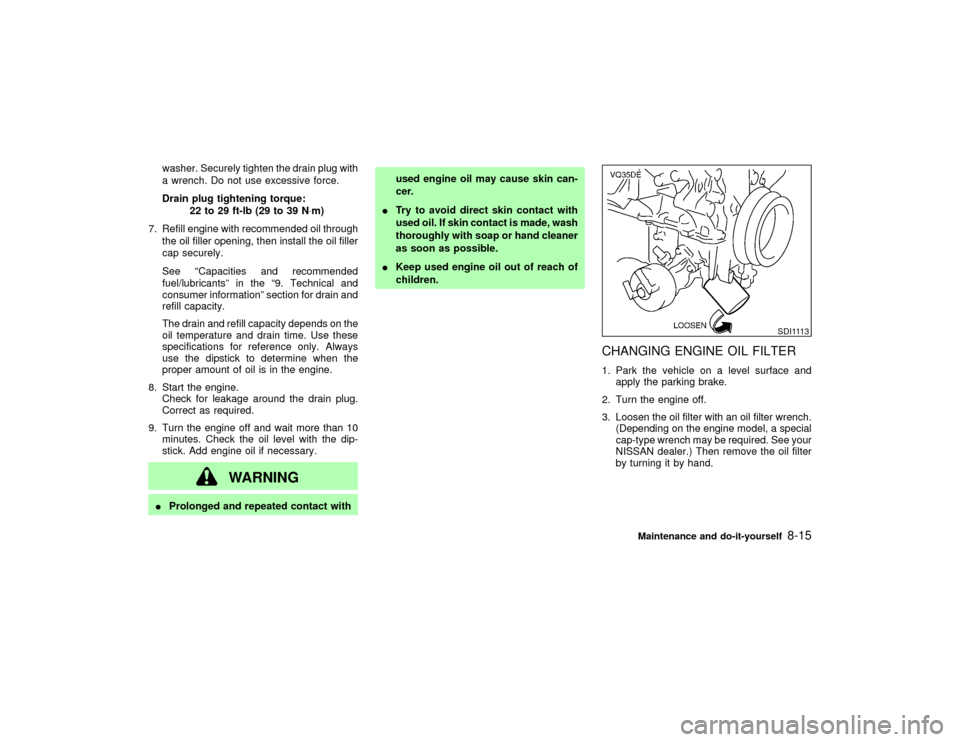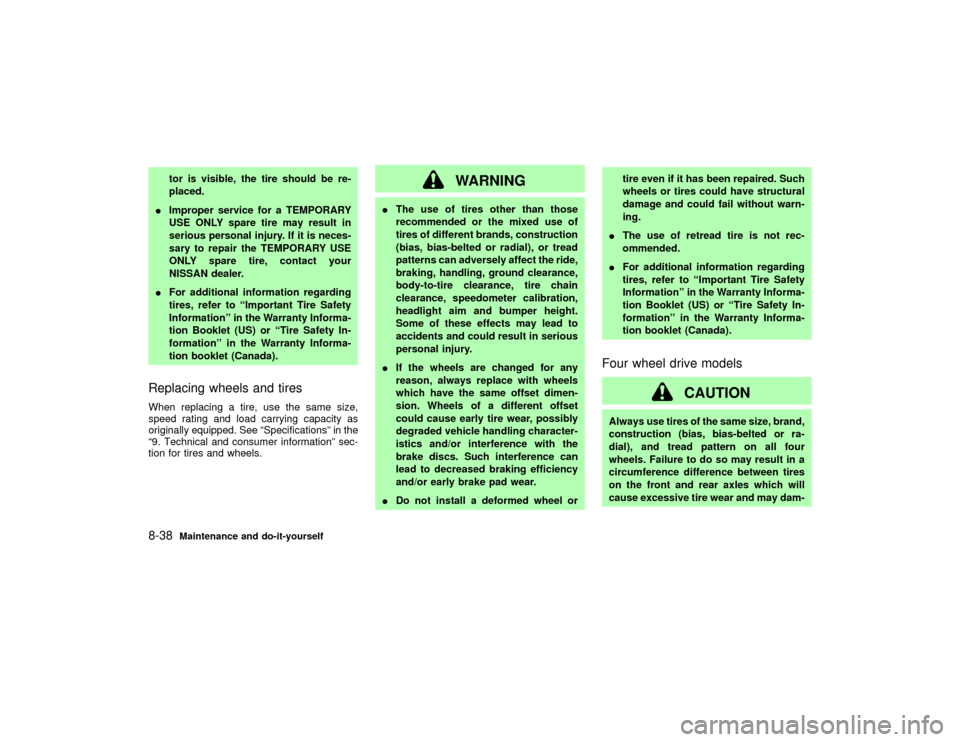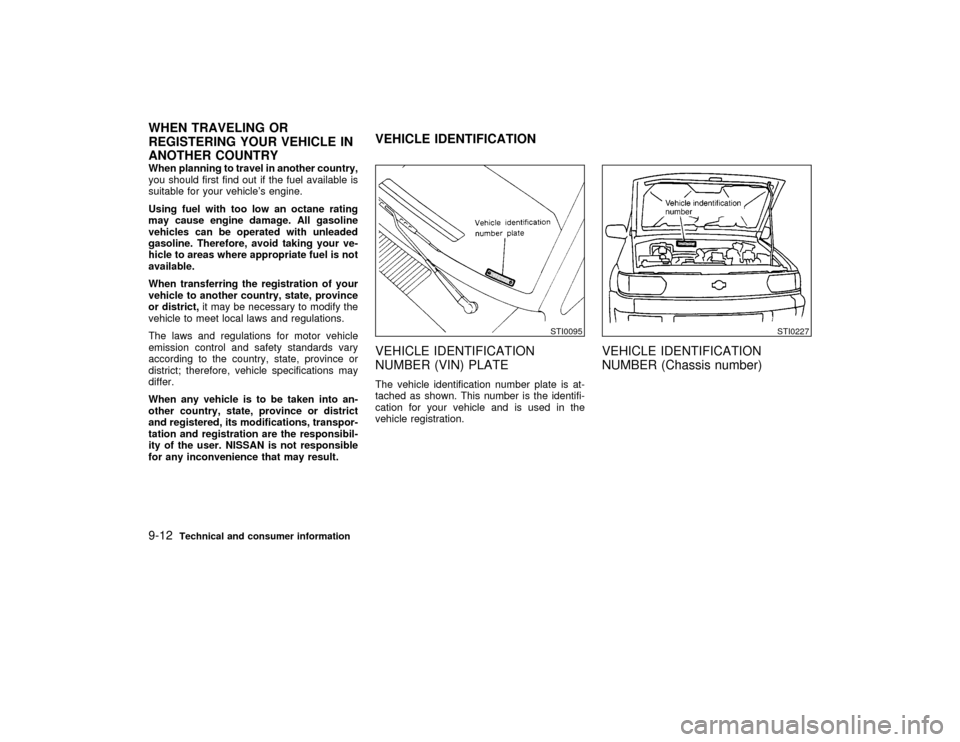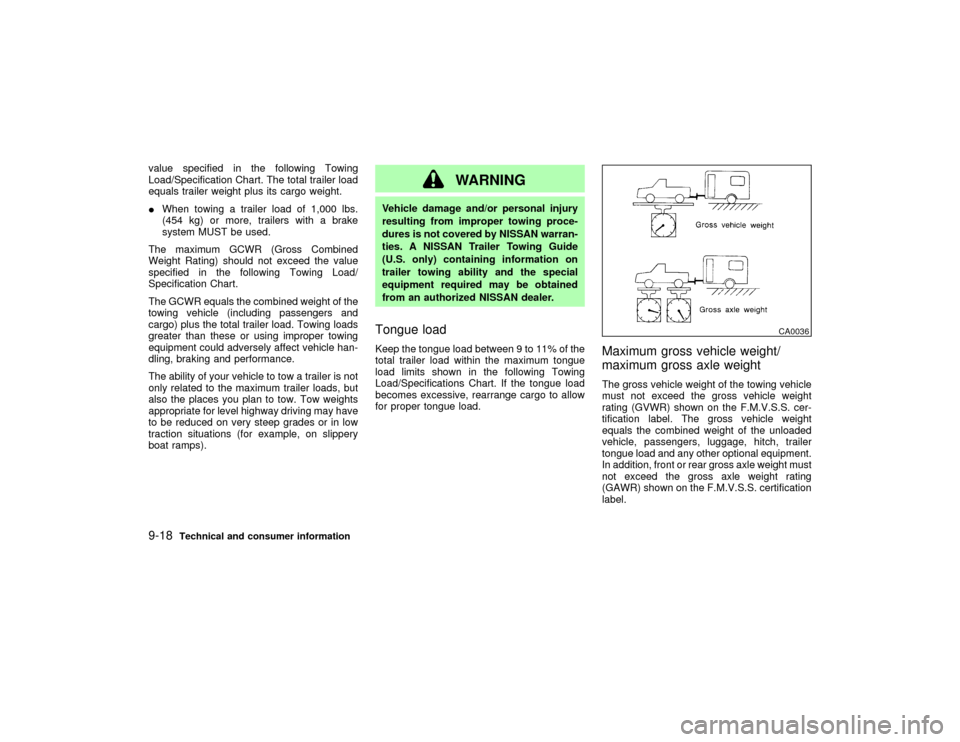2002 NISSAN PATHFINDER technical specifications
[x] Cancel search: technical specificationsPage 224 of 288

washer. Securely tighten the drain plug with
a wrench. Do not use excessive force.
Drain plug tightening torque:
22 to 29 ft-lb (29 to 39 N×m)
7. Refill engine with recommended oil through
the oil filler opening, then install the oil filler
cap securely.
See ªCapacities and recommended
fuel/lubricantsº in the ª9. Technical and
consumer informationº section for drain and
refill capacity.
The drain and refill capacity depends on the
oil temperature and drain time. Use these
specifications for reference only. Always
use the dipstick to determine when the
proper amount of oil is in the engine.
8. Start the engine.
Check for leakage around the drain plug.
Correct as required.
9. Turn the engine off and wait more than 10
minutes. Check the oil level with the dip-
stick. Add engine oil if necessary.
WARNING
IProlonged and repeated contact withused engine oil may cause skin can-
cer.
ITry to avoid direct skin contact with
used oil. If skin contact is made, wash
thoroughly with soap or hand cleaner
as soon as possible.
IKeep used engine oil out of reach of
children.
CHANGING ENGINE OIL FILTER1. Park the vehicle on a level surface and
apply the parking brake.
2. Turn the engine off.
3. Loosen the oil filter with an oil filter wrench.
(Depending on the engine model, a special
cap-type wrench may be required. See your
NISSAN dealer.) Then remove the oil filter
by turning it by hand.
SDI1113
Maintenance and do-it-yourself
8-15
Z
01.9.21/R50-D/V5
X
Page 247 of 288

tor is visible, the tire should be re-
placed.
IImproper service for a TEMPORARY
USE ONLY spare tire may result in
serious personal injury. If it is neces-
sary to repair the TEMPORARY USE
ONLY spare tire, contact your
NISSAN dealer.
IFor additional information regarding
tires, refer to ªImportant Tire Safety
Informationº in the Warranty Informa-
tion Booklet (US) or ªTire Safety In-
formationº in the Warranty Informa-
tion booklet (Canada).
Replacing wheels and tiresWhen replacing a tire, use the same size,
speed rating and load carrying capacity as
originally equipped. See ªSpecificationsº in the
ª9. Technical and consumer informationº sec-
tion for tires and wheels.
WARNING
IThe use of tires other than those
recommended or the mixed use of
tires of different brands, construction
(bias, bias-belted or radial), or tread
patterns can adversely affect the ride,
braking, handling, ground clearance,
body-to-tire clearance, tire chain
clearance, speedometer calibration,
headlight aim and bumper height.
Some of these effects may lead to
accidents and could result in serious
personal injury.
IIf the wheels are changed for any
reason, always replace with wheels
which have the same offset dimen-
sion. Wheels of a different offset
could cause early tire wear, possibly
degraded vehicle handling character-
istics and/or interference with the
brake discs. Such interference can
lead to decreased braking efficiency
and/or early brake pad wear.
IDo not install a deformed wheel ortire even if it has been repaired. Such
wheels or tires could have structural
damage and could fail without warn-
ing.
IThe use of retread tire is not rec-
ommended.
IFor additional information regarding
tires, refer to ªImportant Tire Safety
Informationº in the Warranty Informa-
tion Booklet (US) or ªTire Safety In-
formationº in the Warranty Informa-
tion booklet (Canada).
Four wheel drive models
CAUTION
Always use tires of the same size, brand,
construction (bias, bias-belted or ra-
dial), and tread pattern on all four
wheels. Failure to do so may result in a
circumference difference between tires
on the front and rear axles which will
cause excessive tire wear and may dam-
8-38
Maintenance and do-it-yourself
Z
01.9.21/R50-D/V5
X
Page 252 of 288

9 Technical and consumer informationCapacities and recommended fuel/lubricants ........... 9-2
Fuel recommendation........................................... 9-4
Engine oil and oil filter recommendation .............. 9-6
Recommended SAE oil viscosity number ............ 9-7
Air conditioning system refrigerant and lubricant
recommendations ................................................. 9-8
Specifications ............................................................ 9-9
Engine .................................................................. 9-9
Wheels and tires ..................................................... 9-11
Dimensions and weights .................................... 9-11
When traveling or registering your vehicle in another
country..................................................................... 9-12
Vehicle identification ............................................... 9-12
Vehicle identification number (VIN) plate ........... 9-12
Vehicle identification number (Chassis
number) .............................................................. 9-12
Engine serial number ......................................... 9-13
F.M.V.S.S. certification label .............................. 9-13
Emission control information label ..................... 9-14
Tire placard ........................................................ 9-14Air conditioner specification label ....................... 9-14
Vehicle loading information ..................................... 9-15
Terms ................................................................. 9-15
Determining vehicle payload capacity ................ 9-15
Securing the load ............................................... 9-16
Loading tips ........................................................ 9-16
Payload weight capacity ..................................... 9-17
Measurement of weights .................................... 9-17
Towing a trailer ....................................................... 9-17
Maximum load limits ........................................... 9-17
Towing load/specification chart .......................... 9-19
Towing safety ..................................................... 9-19
Uniform tire quality grading ................................ 9-21
Emission control system warranty .......................... 9-22
Reporting safety defects (US only) ......................... 9-22
Readiness for inspection/maintenance (I/M) test
(US only) ................................................................. 9-23
Owner's Manual/Service Manual order
information............................................................... 9-25
In the event of a collision ................................... 9-25
Z
01.9.21/R50-D/V5
X
Page 253 of 288

The following values are approximate capacities. The actual refill capacities may be a little different from them. When refilling, follow the
procedure instructed in the ª8. Maintenance and do-it-yourselfº section to determine the proper refill capacity.
Capacity (Approximate)
Recommended specifications
US
measureImp
measureLiter
Fuel 20-7/8 gal 17-3/8 gal 79Unleaded gasoline with an octane rating
of at least 91 AKI (RON 96) (VQ35DE) or
87AKI (RON 91) (VG33E)*1
Engine oil*4
Drain and refill
with oil filter
change5-1/4 qt 4-3/8 qt 5.0IAPI Certification Mark*2 *3
IAPI grade SG/SH, Energy Conserving I
& II or API grade SJ, Energy Conserv-
ing*2 *3
IILSAC grade GF-I & GF-II*2 *3 without oil filter
change5-1/8 qt 4-1/4 qt 4.8
Cooling system
(with heater and
reservoir tank)9-3/4 qt 8-1/8 qt 9.2Genuine Nissan Anti-Freeze Coolant or
equivalent
*1: See later in this section for fuel recommendation.
*2: See later in this section for recommended SAE viscosity number.
*3: See later in this section for engine oil and oil filter recommendation.
*4: See ªChanging engine oilº in the ª8. Maintenance and do-it-yourselfº section for further details.CAPACITIES AND
RECOMMENDED
FUEL/LUBRICANTS9-2
Technical and consumer information
Z
01.9.21/R50-D/V5
X
Page 254 of 288

Capacity (Approximate)
Recommended specifications
US
measureImp
measureLiter
Manual transmissionÐ Ð Ð API GL-4 Viscosity SAE 75W-85 only
Differential gear oil (exc. LSD)Ð Ð Ð API GL-5*1
Limited-slip differential (LSD) gear oil Ð Ð ÐOnly LSD gear oil:
API GL-5 and SAE 80W-90*2 approved for Nissan LSD*3
Automatic transmission fluid
Refill to the proper oil level according to the instruc-
tions in the ª8. Maintenance and do-it-yourselfº sec-
tion.Nissan Matic ªDº (Continental U.S. and Alaska) or Canada
NISSAN Automatic Transmission Fluid.*6
Power steering fluidGenuine Nissan PSF II or equivalent*7
All-mode 4WD transfer fluidNissan Matic ªDº (Continental U.S. and Alaska) or Canada
NISSAN Automatic Transmission Fluid.*8
Transfer fluidNissan Matic ªCº*6 or API GL-4*1
Brake and clutch fluidGenuine Nissan Brake Fluid*4 or equivalent
DOT 3 (U.S. F.M.V.S.S. No. 116)
Propeller shaft greaseÐ Ð Ð NLGI No. 2 (Molybdenum disulphide lithium soap base)
Multi-purpose greaseÐ Ð Ð NLGI No. 2 (Lithium soap base)
Air conditioning system refrigerantÐ Ð Ð HFC-134a (R-134a)*5
Air conditioning system lubricantsÐ Ð Ð Nissan A/C System Oil Type S or exact equivalent*5
*1: For further details, see recommended SAE viscosity number chart.
*2: SAE 90 is acceptable in temperatures above 0ÉF (þ18ÉC).
*3: Contact your NISSAN dealer for a list of approved oils.
*4: Available in mainland U.S. through your NISSAN dealer.
*5: See ªVehicle identificationº later in this section for air conditioner specification label.
*6: Never mix Nissan Matic ªCº and API GL-4 oil.
*7: Genuine Nissan PSF, Canada NISSAN Automatic Transmission Fluid, DEXRON
TMIII/MERCON
TM
or equivalent ATF may also be used.
*8: Outside the continental U.S. and Alaska contact an authorized NISSAN dealer for more information regarding suitable fluids, including recommended brand(s) of
DEXRON
TMIII/MERCON
TM
Automatic Transmission Fluid.
Technical and consumer information
9-3
Z
01.9.21/R50-D/V5
X
Page 260 of 288

ENGINE
Model VQ35DE VG33E
Type Gasoline, 4-cycle Gasoline, 4-cycle
Cylinder arrangement 6-cylinder, V-slanted at 60É 6-cylinder, V-slanted at 60É
Bore´Stroke in (mm) 3.760´3.205 (95.5´81.4) 3.602´3.268 (91.5´83.0)
Displacement
cu in (cm
3)213.45 (3,498) 199.84 (3,275)
Firing order 1-2-3-4-5-6 1-2-3-4-5-6
Idle speed rpm
See the ªEmission control
labelº on the underside of the hood.See the ªEmission control
labelº on the underside of the hood. Ignition timing (BTDC)
degree/rpm
CO percentage at idle speed
[No air] %
Spark plug PL FR5A-11 (Standard) FR4AP-10 (Hot)
PL FR4A-11 (Service option) FR5AP-10 (Standard)
PL FR6A-11 (Service option) FR6AP-10 (Cold)
Spark plug gap in (mm) 0.043 (1.1) 0.039 (1.0)
Camshaft operation Timing chain Timing belt*1
Alternator belt size
Width´Length
in (mm)0.8409´46.26 (21.36´1,175) 0.8409´41.93 (21.36´1,065)
*1: Periodic maintenance is necessary. See ªPeriodic maintenanceº in the ªService and Maintenance Guideº for maintenance intervals.
SPECIFICATIONS
Technical and consumer information
9-9
Z
01.9.21/R50-D/V5
X
Page 263 of 288

When planning to travel in another country,
you should first find out if the fuel available is
suitable for your vehicle's engine.
Using fuel with too low an octane rating
may cause engine damage. All gasoline
vehicles can be operated with unleaded
gasoline. Therefore, avoid taking your ve-
hicle to areas where appropriate fuel is not
available.
When transferring the registration of your
vehicle to another country, state, province
or district,it may be necessary to modify the
vehicle to meet local laws and regulations.
The laws and regulations for motor vehicle
emission control and safety standards vary
according to the country, state, province or
district; therefore, vehicle specifications may
differ.
When any vehicle is to be taken into an-
other country, state, province or district
and registered, its modifications, transpor-
tation and registration are the responsibil-
ity of the user. NISSAN is not responsible
for any inconvenience that may result.
VEHICLE IDENTIFICATION
NUMBER (VIN) PLATEThe vehicle identification number plate is at-
tached as shown. This number is the identifi-
cation for your vehicle and is used in the
vehicle registration.
VEHICLE IDENTIFICATION
NUMBER (Chassis number)
STI0095
STI0227
WHEN TRAVELING OR
REGISTERING YOUR VEHICLE IN
ANOTHER COUNTRYVEHICLE IDENTIFICATION9-12
Technical and consumer information
Z
01.9.21/R50-D/V5
X
Page 269 of 288

value specified in the following Towing
Load/Specification Chart. The total trailer load
equals trailer weight plus its cargo weight.
IWhen towing a trailer load of 1,000 lbs.
(454 kg) or more, trailers with a brake
system MUST be used.
The maximum GCWR (Gross Combined
Weight Rating) should not exceed the value
specified in the following Towing Load/
Specification Chart.
The GCWR equals the combined weight of the
towing vehicle (including passengers and
cargo) plus the total trailer load. Towing loads
greater than these or using improper towing
equipment could adversely affect vehicle han-
dling, braking and performance.
The ability of your vehicle to tow a trailer is not
only related to the maximum trailer loads, but
also the places you plan to tow. Tow weights
appropriate for level highway driving may have
to be reduced on very steep grades or in low
traction situations (for example, on slippery
boat ramps).
WARNING
Vehicle damage and/or personal injury
resulting from improper towing proce-
dures is not covered by NISSAN warran-
ties. A NISSAN Trailer Towing Guide
(U.S. only) containing information on
trailer towing ability and the special
equipment required may be obtained
from an authorized NISSAN dealer.Tongue loadKeep the tongue load between 9 to 11% of the
total trailer load within the maximum tongue
load limits shown in the following Towing
Load/Specifications Chart. If the tongue load
becomes excessive, rearrange cargo to allow
for proper tongue load.
Maximum gross vehicle weight/
maximum gross axle weightThe gross vehicle weight of the towing vehicle
must not exceed the gross vehicle weight
rating (GVWR) shown on the F.M.V.S.S. cer-
tification label. The gross vehicle weight
equals the combined weight of the unloaded
vehicle, passengers, luggage, hitch, trailer
tongue load and any other optional equipment.
In addition, front or rear gross axle weight must
not exceed the gross axle weight rating
(GAWR) shown on the F.M.V.S.S. certification
label.
CA0036
9-18
Technical and consumer information
Z
01.9.21/R50-D/V5
X